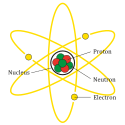Ghulam Dastagir Alam
Ghulam Dastagir Alam Qasmi | |
|---|---|
Quaid-e-Azam University | |
| Theses | |
| Doctoral advisor | J. B. Hasted |
| Other academic advisors | |
Ghulam Dastagir Alam Qasmi (
After the atomic bomb project, Alam joined the Department of Mathematics at the Quaid-e-Azam University (QAU) as well as serving as
Biography
Alam was educated at the Government College University in Lahore where he studied in 1951 and graduated with Bachelor of Science (BSc) in Mathematics in 1955 under the supervision of Abdus Salam–a theoretical physicist.[4] He then went to attend the physics program at the Punjab University where he graduated with Master of Science (MSc) in Physics in 1957, supervised under Dr. Rafi Muhammad– a nuclear physicist.[4]
His thesis titled: The Emission of Electromagnetic Radiations from metals by high energy particles, had contained investigations on electromagnetic radiation emitted from the heavy metals by bombarding the elementary particles.[4][5]
In 1964, Alam joined the doctoral program in physics at the
In 1967, he published another thesis jointly written by J.B. Hasted and D.K. Bohme on physics of atomic collision and potential energy curves— their work was supported and funded by the United States Department of Defense.[7]
While in the United Kingdom, Alam continued publishing and working on the atomic physics and atomic collisions, collaborating with many other of his British colleagues.[8] However, Alam lost interests in atomic physics and became interested in computer programming and mathematics.: 80, 425 [3] In 1970, he published a paper on gamma rays and performed an experiment on isomers, proposing and later proving mathematically that, in the isomer state, the average kinetic energy associated with the decay process of Isomer state is about the same in the ground state of fission.[9]
Pakistan Atomic Energy Commission
1971 war, atomic bomb program, and centrifuge technology

In 1958, Alam joined the
Alam originally was not part of the team that was investigating the uranium enrichment under
In 1976, Alam was asked to review the components and the blueprints of a gas centrifuge brought by
In April 1976, Alam succeeded in designing a gas centrifuge and succeeded in rotating the first centrifuge to 30,000 rpm by perfectly balancing and rotating around fixed axis of the centrifuge— Alam and his team was immediately dispatched at the Khan Research Laboratories under Abdul Qadeer Khan.: 57 [11] At KRL, Alam and Shah worked on solving differential equation problems relating the gas centrifuges, and designed a first generation of centrifuges, known as P1, that succeeded in separating the U234, U235, and U238 isotopes from raw natural uranium under supervision of Shah, Alam, and Qadeer Khan.: 58–59 [11] Commenting on the success, Alam famously quoted: "Boys, we have achieved enrichment in Pakistan.": 148–149 [3] Following this success, Alam and other colleagues signed and quickly published a paper on the differential methods of the centrifuges in 1978–79.: 150–151 [3]
Alam remained associated with the centrifuge program and was its design director until 1981 when he developed intellectual differences with Abdul Qadeer Khan in 1981.: 431
Alam went to join the Quaid-i-Azam University and briefly taught courses on calculus, and published a computer model on HIV rate of infection along with American scientists.: 389
Books
- ISBN 978-981-270-591-4
- Qasmi, Ghulam Dastigar Alam (April 1996) [1996], Calculus: An Approach to Engineering Mathematics, 1, vol. 1 (1 ed.), Department of Mathematics, Quaid-e-Azam University: Punjab Text Board, p. 390
Science articles
- Fission fragment mass distributions and kinetic energies for spontaneous fission isomers, by R.L. Ferguson, F. Plasil, G.D. Alam†, H.W. Schmitt.
- Gamma Ray Transitions in the de-excitation Californium-253 spontenous fission pragments, by G.D. Alam, Department of Mathematics.
Bibliography

- Shahidur Rehman (1999). Long Road to Chagai:§ Gas centrifuge controversy§Pakistan nuclear technology project: from Pakistan's Theoretical Physics to the making of the bomb. Pakistan, UK: Printwise Publications. p. 157.
- Levy, Adrian; Scott-Clark, Catherine (2007). Deception: Pakistan, the United States, and the Secret Trade in Nuclear Weapons. New York: Walker & Co./Holtzbrinck. p. 586. ISBN 978-0-8027-1554-8.
- Albright, David (2010). Peddling Peril§ Its Just Business. United States: Free Press. p. 296. ISBN 978-1-4165-4931-4.
References
- ^ Allam, GD; Rashid, Khalid; Ahmad, Maqsood; Qureshi, I.E.; Ali, Anwar; Khan, Naeem Ahmad; Bhatti, Nasim; Horsh, F. (1 November 1983). "GAMMA RAY TRANSITIONS IN DE-EXCITATION OF CF-252 SPONTANEOUS FISSION FRAGMENTS" (PDF). www.inis.iaea.org. Nilore, Islamabad: IAEA and PINSTECH. p. 28. Retrieved 9 August 2020.
- ISBN 978-0-323-15052-1. Retrieved 9 August 2020.
- ^ ISBN 978-0804776011. Retrieved 28 February 2013.
- ^ a b c Qasmi, GD Allam. "The Emission of Electromagnetic Radiations from metals by high energy particles". www.defence.pk/pdf/. Islamabad: NM Butt. Retrieved 8 August 2020.
- ^ N. M. Butt, “Nuclear Radiation Education and Nuclear Science and Technology in Pakistan,” paper presented to the 2nd International Congress on Radiation Education in Debrecen, Hungary
- ^ a b c d Alam, GD (1 February 1967). "Electron Capture by Multiply Charged Ions" (PDF). www.discovery.ucl.ac.uk. London, Eng. UK: University College London Press. p. 142. Retrieved 8 August 2020.
- ^ W. Benjamin., 1967, United States. Dept. of Defense (1967). "Charge Transfer Involving Curve Crossin". W. Benjamin., 1967. United States. Dept. of Defense. Retrieved 27 December 2011.
{{cite web}}: CS1 maint: numeric names: authors list (link) - ISBN 9780080564647.
- ISBN 3-540-23302-4.
- ^ "Archived copy" (PDF). Archived from the original (PDF) on 3 May 2016. Retrieved 8 August 2020.
{{cite web}}: CS1 maint: archived copy as title (link) - ^ ISBN 978-969-8500-00-9.
- ^ Alam, G.D., Dr. Qadeer Was Ready to Secretly Sell Nuclear Technology to an Arab Country: Dr. G.D. Alam, interview in Assas-o-Lashkar (Urdu), June 12, 1998
- ISBN 978-981-10-3325-4. Retrieved 8 August 2020.
- ^ Alam, Ghulam Dastigar (1997). "Gamma Ray Transitions in the de-excitation Californium-253 spontenous fission pragments". Dr. Ghulam Dastigar Alam, Department of Mathematics, Quaid-e-Azam University. Institution of Electrical. Retrieved 27 December 2011.
